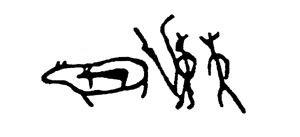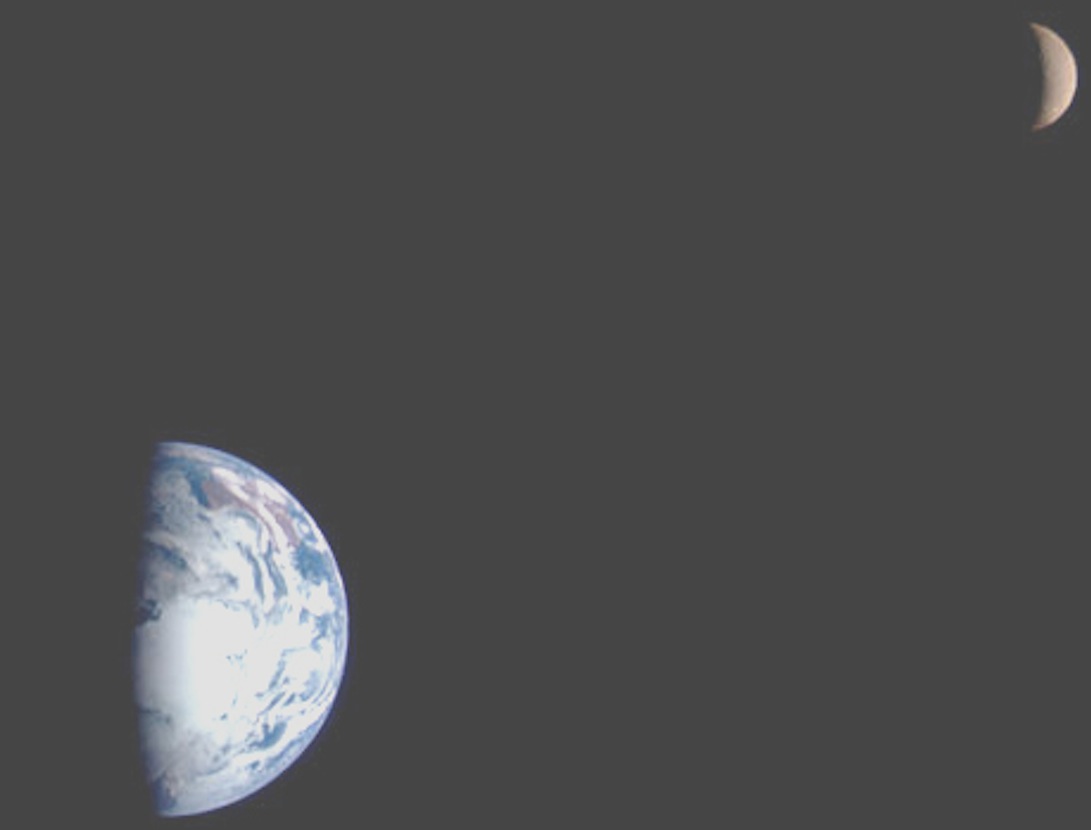 Earth and Moon from space | |
 front of moon |
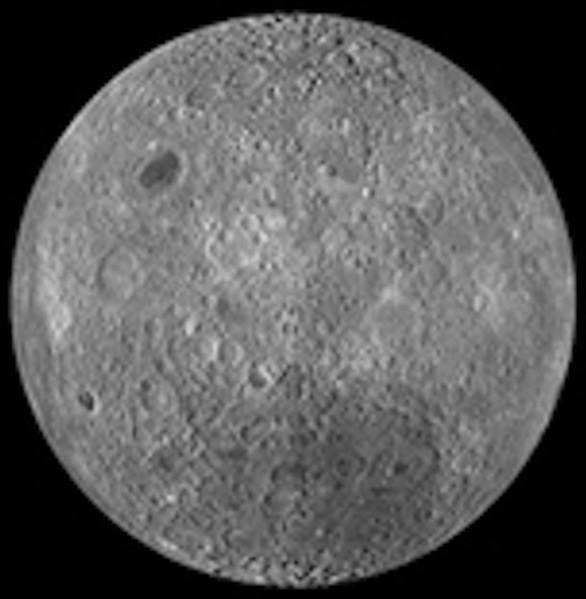 back of moon |
The Captive Moon
 Earth and Moon from space | |
 front of moon |
 back of moon |
The Earth and the Moon were formed separately and are now a twin planet system. There have been several theories to explain the formation of this system. A possible clue lies in the moon being mostly rock, without much of an iron core like the Earth and other rocky planets.
One explanation is that during a major disturbance of the solar system in the first million years of the formation of our sun and its planetary system, the Earth was impacted by another planet, the size of Mars. It had probably formed in the same orbit as the Earth - in one of the Lagrangian points - two places on a planet's orbit of equal distance from the planet which attract debris and other objects. If they are disturbed then they could be drawn into the gravitational field of the planet. This could be what had happened. Since there is no indication from the composition of the Earth and Moon of an object from further out in the solar system being involved. More evidence for Moon forming in collision with a large object which has been called Theia (mother of the moon goddess Selene in Greek mythology). The collision melted and vapourised Theia and much of the Earth's mantle. This rock vapour condensed to form the Moon. More recent studies using computer simulations have shown that the mega-asteroid/small planet the size of present day Mars, that smashed into the Earth, causing the clouds of debris that eventually made up the moon, had occurred about 95 milion years after the birth of the solar system.
A ring of thick dust was discovered in the solar system of another star, BD +20 307, similar to but a little more massive than our sun, and much younger - about 300 million years old, and it is thought now that this may have been caused by a collision of two rocky type planets no more than 1,000 years ago.
Such an impact in our solar system, would have almost destroyed both bodies, and thrown up a ring of the lighter rocks orbiting the Earth, while the heavier molten iron sank into the centre of the Earth. The orbiting rocks would have clumped together by gravity and impact to form the Moon, much nearer to the Earth than today and both bodies were rotating much faster. Having a large body so near affected the Earth's rotation, the friction from the tides has gradually slowed both bodies down, so now the Moon always has the same side facing the Earth. And the Earth has far fewer days in the year. Since then the Moon's orbit has widened and it has been getting further from the Earth.
Heating during accretion melted the outer layers of the newly forming moon leading to the formation of the cratered highlands of the outer crust, which are mainly gabbro anorthosites - granular igneous rocks.
When the Moon was slowed by the Earth's tidal pull until the same side always faced the Earth, the tidal pull caused that side of the Moon to bulge and massive volcanic eruptions which covered great plains with lava, producing the huge dark mare plains and basins easily seen from Earth. The mare plains were filled with radioactive basalts known as KREEP (potassium K, rare earth elements and phosphorous). Circular maria of 200 km in diameter which are about 3000 to 3500 million years old are gravitational field anomalies. They are called MASCONS which is short for "mass concentrations".
From the examination of moon rocks from the manned Apollo missions, it now looks like some 3.7 billion years ago, the moon had a molten metal magnetic core. The moon was then very much closer to the Earth than now. And had many more impacts which would have kept the moon's metal core heated and in motion.
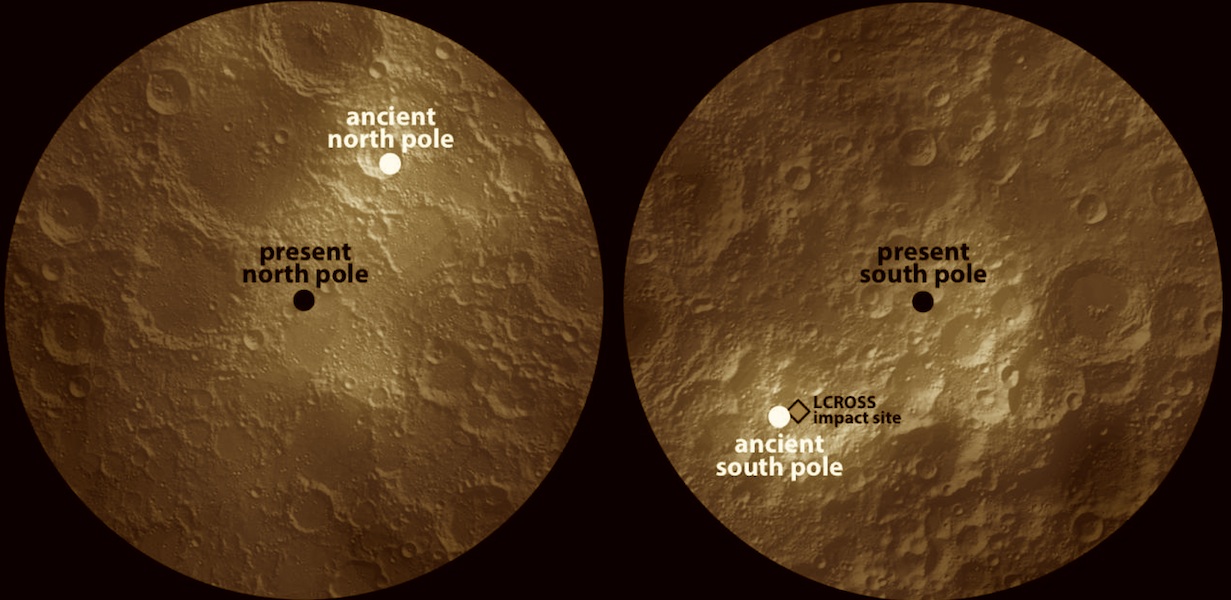 More recent discoveries, have indicated the moon's axis has shifted at least 6 degrees over a billion years. The moon's shift in axis was internal, from the volcanic activity more than 3 and a half billion years ago.
More recent discoveries, have indicated the moon's axis has shifted at least 6 degrees over a billion years. The moon's shift in axis was internal, from the volcanic activity more than 3 and a half billion years ago.
For the past 3000 million years not a lot has happened to the Moon except gradually increasing its orbit around the Earth, and getting hit by meteorites. Its surface has become covered by a fine grained fragmentary rock - the regolith - of varying thickness. The pools of melted magna which was lighter than the colder rocks and rose to the surface, can be seen from Earth as darker patches on the moon's surface.
As the moon gets further from the Earth, the gravitational pull causing tides on both bodies weakens, and the spinning of both bodies about their axis slows. There was once many more days in the year on Earth, and on the moon, the day is about as long now as its orbit around the Earth, so the same side now always faces the Earth.
As there is little water and atmosphere on the moon there is not much in the way of weathering. There are a number of small moonquakes on the side facing the Earth about 700 to 100 a year, which are caused by the tides.
The Moon has hardly any magnetic field, although it looks like it had a stronger magnetic field in the past. The atmospheric pressure is very low, 10 9 Pa.on the surface. This means that the Moon's surface has little protection from meteoritic bombardment, and from the solar wind and cosmic rays (particles and radiation). The daytime temperature is 407 K, and at night 120 K.
The mass of the moon is 7.35 x 1022 Kg. The diameter is 3475 Km. which is just over a quarter the size of the Earth. The mean distance of the moon from the Earth is 384,000 Km., varying from 356.410 Km. at perigee (the nearest point to the Earth) to 406 700 at apogee (the farthest point from the Earth). The period of the Moon's revolution round the Earth is 27.32166 days, and its axial rotation period is 27.32166 days - the same. The friction of the tides due to the gravitational pull between the Earth and the Moon slowed the Moon's axial rotation until it was synchronous with its orbit. The Moon's gravitational field is having the same effect on Earth, but it is taking longer as the Earth is a more massive body. The Earth's rotation is being slowed by about 3/100ths of a second a century. As the Earth slows, its pull on the Moon lessens, so the Moon is receding from the Earth and its orbit expanding at about 2.6 centimetres a year.
In 1959, soon after the launch of the first satellite, Sputnik, the Russian space program, sent Luna 1, past the Moon, then Luna 2, crashed on the Moon, then Luna 3 orbited around the moon and sent back the first pictures of the far side of the Moon, which were picked up at Jodrell Bank and published in British newspapers.
The first time anyone on Earth had seen the other side of the Moon.
In 1963, a new generation of Luna modules were launched, with the aim of getting a package of instruments safely transmitting from the surface. On January 31, 1966, Luna 9 transmitted the first pictures from the surface of the Moon. This was followed that year by Luna 10 which orbited the Moon, Luna 11, Luna 12 and Luna 13 which successfully landed on the Moon. Two telescope arms came out and struck the surface to convey information on the lunar soil. In the same year, as part of the Cold War Space Race, NASA launched its first craft to successfully survey and photograph the Moon as part of the preparations for a manned mission.
After the death of Sergei Korolyev in 1966 the Russian space program concentrated in unmanned missions to the Moon using mobile robot vehicles to travel on the Moon's surface transmitting data and collecting samples of lunar rock to send back to Earth.
In 1968 Luna 14 landed with test equipment. In 1969, just before Apollo 11 was due to land, Luna 15 arrived on the Moon - its orbit adjusted in collaboration with NASA so the craft would not collide. However the attempt to send back samples from the surface of the Moon before the Americans failed.
On September 12 1970, Luna 16 was the first unmanned craft capable of returning soil samples to Earth. It landed in the Sea of Fertility, on September 20th. Then it drilled into the ground and obtained soil and rock fragments down to a depth of 35 cm. It placed the samples into a return capsule. This was launched on 21st September and soft landed by parachute three days later in Kazakhstan.
On November 10th 1970, Luna 17 was launched with the first remote controlled Moon Rover, the Lunakhod 1. This landed safely in the Sea of Rains on 17th November. It sent back more than 200 panoramic pictures and more than 20,000 other pictures. It studied the physical and mechanical properties of the lunar soil at more than 500 points and chemical composition analysed at 25 points. The research programme was ended on 4th October 1971.
February 1972, Luna 20 landed at the edge of the Sea of Fertility. It obtained a core sample of lunar rock and returned it safely to Earth. It landed in the Karakingir river and the recovery vehicles kept falling through the ice to get to it.
When the new version - Lunakhod 2, was carried by Luna 21 to the Moon, in January 1973, the Apollo missions were over, having served their purpose in getting an American man first on the Moon, but with many questions about the Moon unresolved. Lunakhod 2 travelled 23 miles over the Moon's surface, transmitting more than 80,000 television pictures and carrying out more than 800 soil tests in the course of only four months.
Luna 22 was launched in May 1974 and spent most of the following year too, on surveying the Moon from orbit. In October 1974, Luna 23 landed on the Moon but was damaged. Luna 24 arrived on the moon in August 1976 and sent back a sample of rock from the Sea of Crises. It used to be possible to see the Lunakhod and Luna modules at the Exhibition of Economic Achievements in Moscow. And should be possible to see them in the Cosmonautics museum under the memorial in front. (Unless "zakrit" - but we never found this open).
Apollo 11 landed the first men on the Moon in 1969, watched on television by people at home on Earth. I remember trying to keep awake, sore-eyed at four in the morning to watch the first manned landing on the moon, then by five thirty we were woken up by our toddler twins banging their cots and demanding breakfast.
One experiment set up by Apollo 11 on the Moon is still running today.
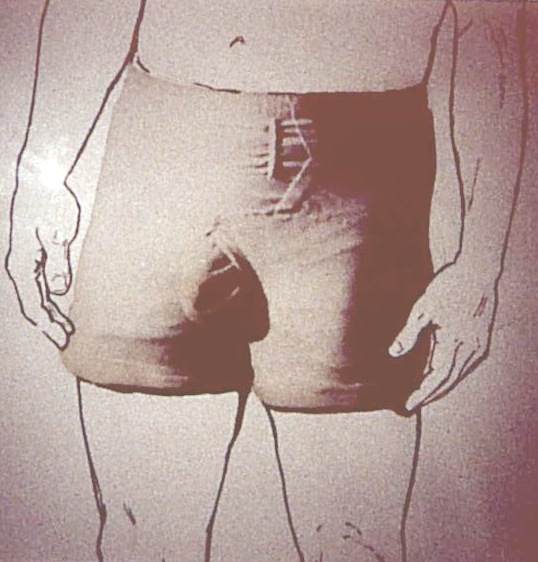 Conditions on board the Apollo craft, were cramped and lacking any facilities. Instead the astronauts wore "fecal retention garments" ie nappies, under their spacesuits and urine was collected in plastic bags. You can see the equipment in the Space Museum, Washington.
Conditions on board the Apollo craft, were cramped and lacking any facilities. Instead the astronauts wore "fecal retention garments" ie nappies, under their spacesuits and urine was collected in plastic bags. You can see the equipment in the Space Museum, Washington.
As a precaution, the first men on the Moon were quarantined on their return, in case they had brought back Lunar life forms with them. But the Moon was sterile when they found it, it had no life at all until they arrived.
As the Apollo astronauts all dumped their rubbish on the Moon, including excrement, the next visitors to the Moon may have a surprise encounter - something might be evolving on the Moon now. Recent probes collected samples of living bacteria from one of the Apollo landing sites.
The most interesting thing on the Moon was its rocks. But despite the importance of collecting and returning samples of moon rock, only one of the astronauts, Harrison (Jack) Smidt, was a geologist, and he got sent on Apollo 17 in 1972 at the insistence of Eugene Shoemaker. And only because the project was curtailed (government money being diverted to the Vietnam war) and this was the last manned mission to the moon.
Apollo 13 launched on April 11 1970, appeased the superstitious by going wrong. NASA problems of returning the three astronauts to Earth alive were tensely watched on television on Earth. It drew attention to the dangers of manned missions.
Twelve Apollo astronauts landed on the Moon altogether, and although they were carefully picked, the parameters for their choice were controversial. Hence the need for continuous pressure from Eugene Shoemaker to send a geologist. So many were religious, that complaints were made both from the scientists involved in the project and the general public, that there was too much religion and not enough science.
There were also complaints from scientists when they saw the astronauts fooling about in the limited time they had on the Moon and damaging expensive equipment. On the Apollo 14 mission, Alan Shepard played golf with a soil sample scoop. On Apollo 16, John Young went for a joy ride on the Lunar Rover, skidding at high speed and also ruined a million dollar experiment. These larks, watched on television at home, did not convince the US government that money was better spent on space than war.
Although there is no evidence to support the myth associating the Moon with madness (hence lunacy) on Earth, some of the Apollo astronauts were a bit unbalanced.
From the Moon the Earth appears four times the size the Moon looks like from Earth. When asked if they had been able to see the Great Wall of China, cities, and other great works of mankind, all the astronauts said that no signs of civilization on Earth could be seen.
Discovered water ice lurked in craters at the poles.
Confirmed water ice at the poles and made the first operational gravity map of the Moon.
The ESA mission.
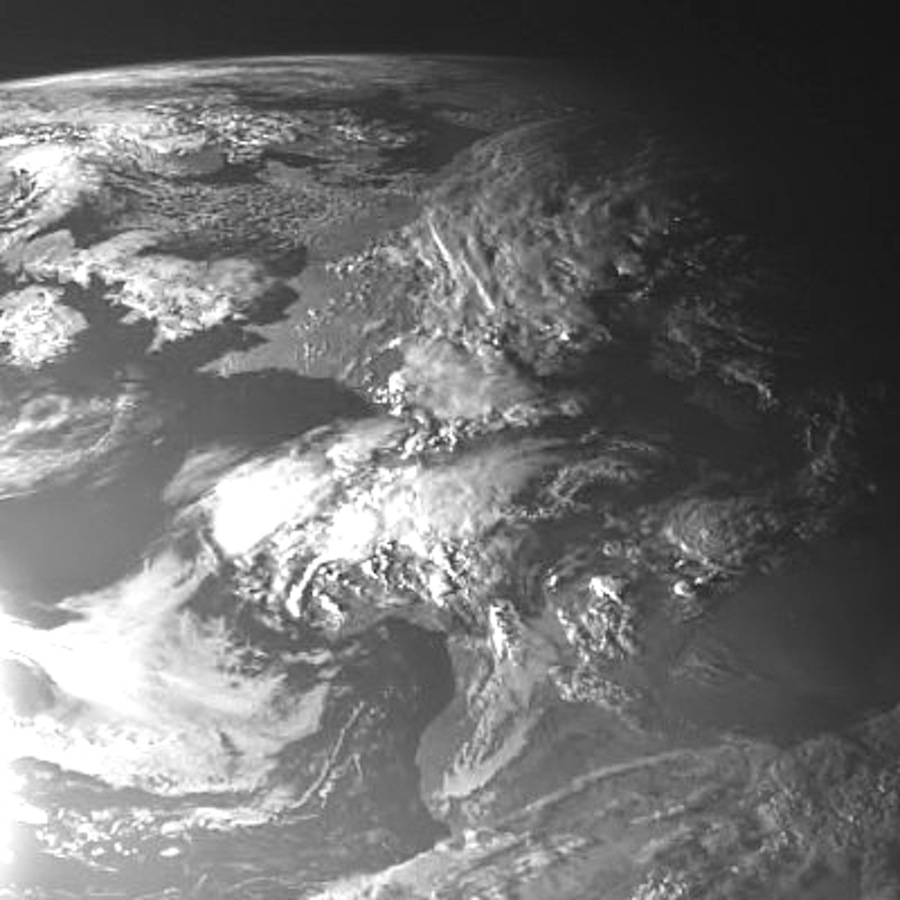 Here is a picture Smart took as it looked back on Earth in 2004 - you can see England.
Here is a picture Smart took as it looked back on Earth in 2004 - you can see England.
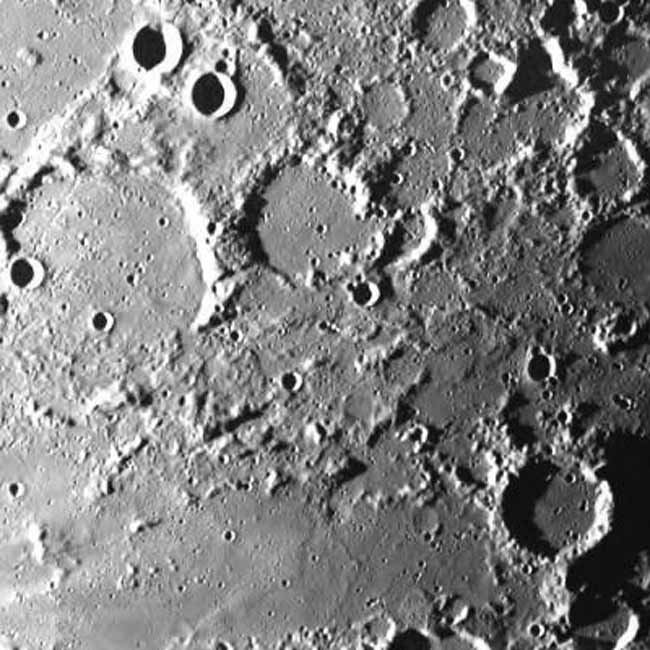 Here is a picture Smart took of the Moon on 29th December 2004.
Here is a picture Smart took of the Moon on 29th December 2004.
Smart-1 was crashed into the Moon 3rd September 2006. During its orbits of the Moon opportunities occurred to observe some interesting events such as a meteorite impacting on the Moon's surface forming a crater. It was also possible to found out more about the composition of the Moon which may confirm the theory of its possible violent origin in a collision with the early Earth.
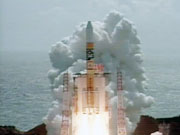
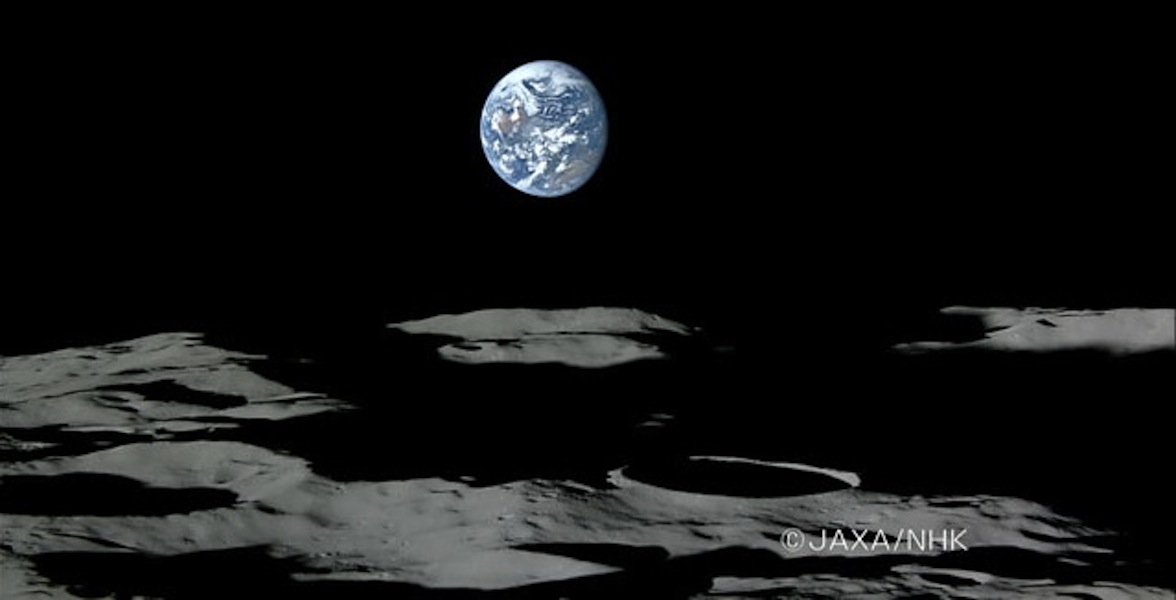
Stunning pictures of the Earth rising and setting from the Moon came back in November 2007.
Kaguya was crashed on to the moon 10th June 2009.
| The Indian Space Research satellite Chandrayaan-1, has been orbiting the moon mapping its surface, its minerals, radiation etc. The picture shows surface and minerals. | 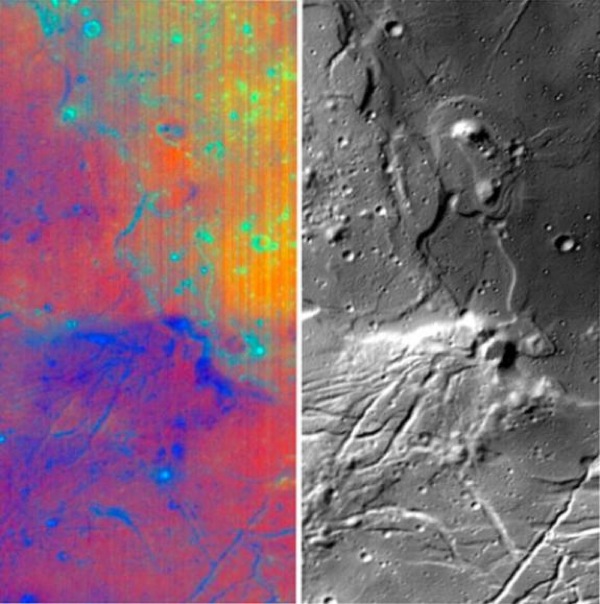 |
GRAIL
the mission to the far side of moon
The Moon revolves once a month, so the same side always faces the Earth - but not quite - a little more can be seen at the edges at times. This is called libration and is due to the lunar orbit (the moon's orbit) not being circular but an ellipse, so the velocity of the Moon varies as it orbits the Earth. It moves greatest at perigee when it is nearest the Earth, and less at apogee, when it is farthest from the Earth. As the rate of the Moon's axle spin is constant, it is possible to see more than half of it from the Earth. This is called "the libration in longitude". There is also a "libration in latitude" because of the inclination of the Moon's orbit, so we can see a short distance round one of the Moon's poles from the Earth. Then there is daily or "diurnal libration" due to the axial rotation of the Earth. At moonrise we can see a little way beyond the eastern limb and at moonset a little way beyond the western limit. As a result of libration, just over 59 per cent of the Moon's surface is visible from the Earth.
The middle of the bow of the crescent lit up by the Sun points at the Sun, so if the sun is still in the sky, the cresent "faces" slightly upwards, in the middle of the night the bow of the crescent faces downwards.
The maximum magnitude of the full Moon is 12.5. Sometimes light reflected back from the Earth makes the whole Moon visible (The Old Moon in the Arms of the New).
The boundary between bright and dark parts of the Moon is called the terminator. The "points of the Moon" are called cusps.
The Moon appears to move eastward against the background of stars by about 13 degrees per day and therefore rises later on successsive days. The time difference between one moonrise and the next is called retardation. The average is 50 minutes, but it varies through the year. In the northern hemisphere it greatest around March when the angle of the Moon's path to the horizon is steep. It is least in September when the angle is shallow and the full moon rises early in the evening. This is called the "harvest moon". Being near the horizon, it appears larger than it really is. This is called the "moon illusion". In a photo of the moon it will not look as large.
This article is about the Harvest Moon, and also about the moonlit world. It explains the mystery of our limited vision in moonlight without any bright light, and how we cannot see in colour, or clearly and have a central blind spot. I am pleased to have the central blind spot explained. It becomes more obvious when you are older and aware of deteriorating vision - but it is normal in low light conditions."
See also:
Moon's Phases
The Sun lights up one side of the Moon. Only the lit up side can be seen from the Earth. So the amount of Moon seen from the Earth depends on the angle between the Sun, Moon, and Earth.
New Moon (invisible, then seen as a thin crescent) 
First quarter (Half the Moon's face can be seen lit) 
Gibbous - nearly full Full (The whole of the side of the Moon facing the Earth can be seen) 
Gibbous (squashed looking) Third quarter 
Old (a thin crescent). Types of Month
